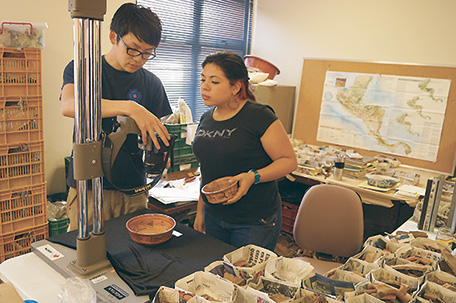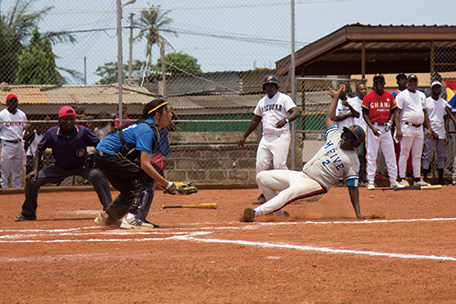(5) Cultural Preservation and Promotion
In developing countries, there is a growing interest in the preservation and promotion of their unique cultures. Cultural heritages that symbolize countries are not only sources of pride for those people, but are also resources that can be effectively utilized for tourism, to develop the socio-economic environment of surrounding areas for local residents. On the other hand, many cultural heritages in developing countries are at risk in terms of preservation and maintenance. The assistance to protect cultural heritage can be viewed as cooperation that directly reaches the hearts of the people in those countries, and has long-term impacts. In addition, the preservation and promotion of culture, such as invaluable cultural heritage that is shared by all humankind, is an issue that should be addressed not only by the countries with cultural heritage in danger, but also by the entire international community as well.
< Japan's Efforts >

A Japan Overseas Cooperation Volunteer, Mr. Hiroaki Yagi (archeology), teaching how to keep antiquities records at an archaeological museum in San Salvador, the capital city of El Salvador. (Photo: Ernest Manzano / JICA)
Japan has continued to contribute to the promotion of culture and higher education, as well as preservation of cultural heritage in developing countries through Cultural Grant Assistance* since 1975. Specifically, Japan has constructed facilities for preserving and utilizing cultural heritage and cultural properties, sports and cultural facilities, higher education and research organization facilities, and provided the necessary equipment for these facilities. Those facilities built in developing countries are also used as bases for providing information about Japan, and for cultural exchanges with Japan, as well as for deepening understanding of Japan and fostering a sense of affinity towards Japan. In recent years, from the viewpoint of “Japan Promotion,” Japan has also emphasized support for Japanese language education and support that contributes to disseminating Japanese contents.
In FY2013, Japan provided assistance in a wide range of areas. In addition to proactive assistance in the sports field in the lead-up to the 2020 Tokyo Olympic and Paralympic Games, Japan provided assistance for the preservation of cultural heritage and assistance through the provision of Japanese documentaries and educational TV programs. In the area of sports, Japan provided assistance for the improvement of sport facilities and equipment in 17 countries. In the area of cultural heritage preservation, Japan decided to implement a project for the construction of the Petra Museum in Jordan, as well as to provide equipment for the preservation and restoration of the Western Causeway of Angkor Wat in Cambodia. Furthermore, Japan supported the provision and improvement of Japanese TV program software in five countries.
Japan has contributed to the restoration and preservation of cultural heritage, including equipment provision and preliminary studies and surveys, through “the Japanese Funds-in-Trust for the Preservation of the World Cultural Heritage” established through UNESCO. Placing an emphasis on human resources development in developing countries, Japan has also been providing assistance by dispatching international experts, which mainly include Japanese experts, and holding workshops in order to transfer techniques and knowledge to developing countries. Japan has also been supporting intangible cultural heritage such as traditional dances, music, handcraft techniques, and oral traditions by implementing projects of successor training, records conservation, creation of preservation mechanisms, and other activities through “the Japanese Funds-in-Trust for the Safeguarding of the Intangible Cultural Heritage” established in UNESCO.
- *Cultural Grant Assistance
- Cultural Grant Assistance provides funding to contribute to the promotion of culture and higher education and the preservation of cultural heritage in developing countries (procurement of equipment, and construction of facilities, etc.) “Cultural Grant Assistance” includes “General Cultural Grant Assistance” which provides assistance to governmental organizations, and “Grant Assistance for Cultural Grassroots Projects,” which provides assistance to NGOs and local public entities for small-scale projects.
| Ghana
The Project for Construction of Baseball and Softball Field at Labone Senior Secondary School
Grant Assistance for Cultural Grassroots Projects (February 1, 2013 – March 31, 2014)

At the hand-over ceremony and the opening game at the baseball and softball field of Labone Senior Secondary School. A scene from an exciting game. (Photo: Yoko Higuchi)

Commemorative photograph taken after the hand-over ceremony and the opening game at the baseball and softball field of Labone Senior Secondary School. Everyone is showing a happy simile. (Photo: Embassy of Japan in Ghana)
In March 2014, the construction of Ghana's first genuine baseball field was completed with support from Japan. The field is named “KOSHIEN1 GHANA.” Although football is by far the most popular sport in Ghana, baseball and softball have begun to fully take root in the country, in part due to the many years of supports extended by Japanese nationals living in Ghana. The excitement of baseball and softball – throwing, hitting, and chasing a white ball – is catching on in the land of Africa. The baseball-playing population in Ghana has been increasing year by year, thanks to the activities of organizations such as the Ghana Baseball and Softball Association (GHABSA), the Ohayo Ghana Foundation, a Japanese NGO in Ghana and the Association for Friends of African Baseball (AFAB), a Japanese NGO that has long supported the promotion of baseball in Ghana.
Be that as it may, baseball practices and games had been conducted in unmaintained vacant lands and school grounds. Therefore, this Grant Assistance for Cultural Grassroots Projects was implemented to install a backstop, replace the soil, and take other measures to create a baseball and softball field. This field was made by the hands of people who love baseball. In the final phase of the work, the members of GHABSA as well as Ghana's veteran and young baseball players and baseball-playing boys gathered at the field to work with volunteers from the Embassy of Japan in putting down baseball bases, removing small stones, and smoothing the ground with a roller.
It is expected that KOSHIEN, the product of joint efforts by the Japanese and the Ghanaian people, will contribute to the development of sound physical and mental health of Ghanaian boys and girls through the sport of baseball and softball. Today as well, Ghana's baseball-playing boys and girls are chasing a white ball with their friends at KHOSHIEN.
*1 KOSHIEN is the name of one of famous baseball stadiums in Japan.
